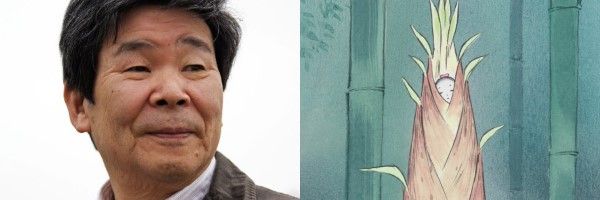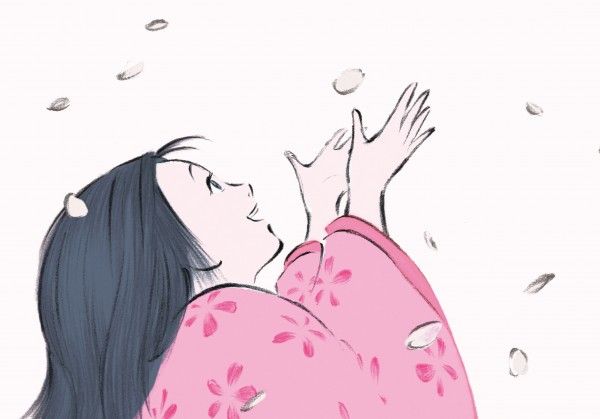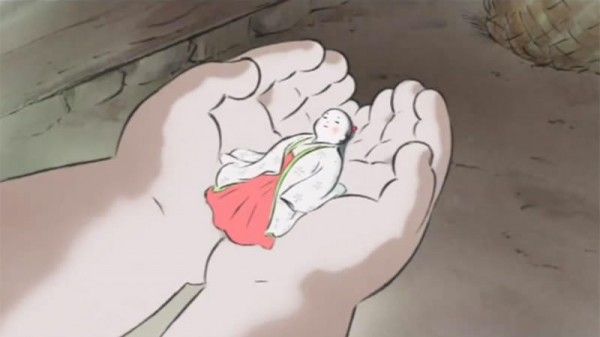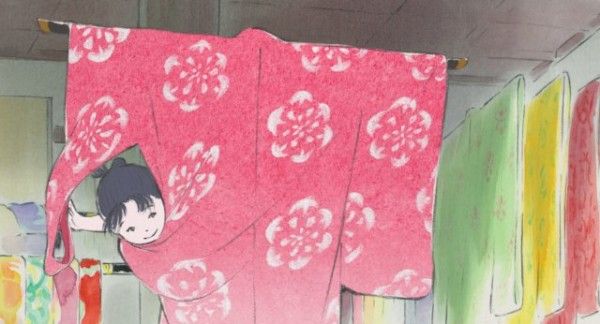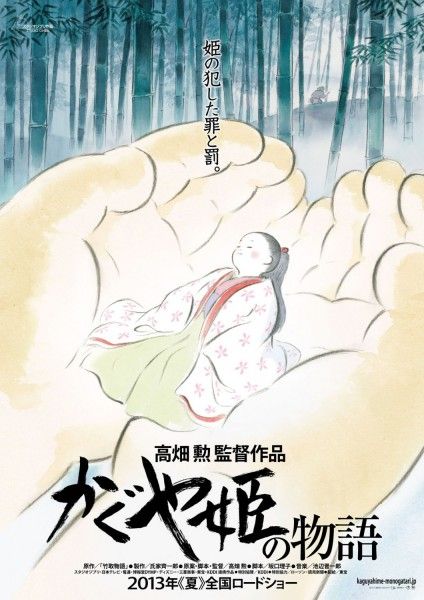One of my personal highlights from this year's Toronto International Film Festival was getting to interview director Isao Takahata for his new film The Tale of Princess Kaguya. If you're not familiar with his name, Isao Takahata is the co-founder of Studio Ghibli along with Hayao Miyazaki, and he previously directed Only Yesterday, Pom Poko, My Neighbors the Yamadas, and the war-themed Grave of the Fireflies (which I can't recommend enough). In his latest movie, which is based on the folktale The Tale of the Bamboo Cutter, Takahata breaks away from Ghibli's familiar animation style and tells a story that embraces the connection between nature and magic. For more on the film, read Matt's review. The Tale of Princess Kaguya will be released in North America on October 17.
During the interview Isao Takahata talked about how he picks his subject matter, how he decided on the look of the film and the style of animation, the storyboard process, why animated films are so popular in Japan with both adults and children, what he collects, the future of Studio Ghibli, his directorial process, and more. Hit the jump for what he had to say.
Note: Since Isao Takahata speaks Japanese, a translator was used. Click here to hear the audio of the interview.
Collider: How do you pick the subject matter that you want to tackle in your movies? I would imagine you have many choices. Can you talk a little bit about how you decide on the material as a director that you want to take on?
ISAO TAKAHATA: Do you mean this particular one or just in general?
In general and also this one.
TAKAHATA: In order to select the subject matter, I think about if this will become an interesting film—if the subject matter is interesting enough. Also, I select subject matters that would allow me to develop new ways to express, in terms of animation.
For your recent film, how did you decide on the look of the film and the animation you chose to tell the story?
TAKAHATA: Actually, I had already decided on what kind of style and what kind of look to give the next animation I would make. Any subject matter that I would’ve chosen, I would’ve used the same kind of style. That’s because I had met a very talented animator, Osamu Tanabe, and I wanted to use his talent to its maximum abilities. I thought I could give him that chance and also that would give me great pleasure.
With many directors of animation, they talk about how the story will undergo many changes in the storyboard process. They might storyboard it again and again and again to achieve the final story. When you’re putting together a film, do you do that as well?
TAKAHATA: In general, in Japan, Hayao Miyazaki is the same way, but I also create a storyboard bit by bit. And then, we don’t change the storyboard once we’ve made it onto the storyboard. We might be a little bit miserly in that way that we don’t want to do lots of trial and error and redo things over and over again.
That’s very different from the American way.
TAKAHATA: Exactly, as you say. I think there are probably good and bad points to either way of doing it but this is the way that we’ve done it, without lots of trial and error. For example, in Hollywood, many people work on a script but we don’t do that either.
This also explains why your films are better in many ways because you don’t have the bureaucracy of many people trying to put their fingerprints on it.
TAKAHATA: Perhaps that’s true.
Have you ever animated something and at the last second pulled it out? Or once you animate something, is it guaranteed to make it in the movie? This pertains to your recent film as well as previous films.
TAKAHATA: Practically never do we delete scenes. It goes back to being miserly; it would be a wasted effort if we went all the way through to animating it and then deleted the scene. I’m sure in live action too, it’s a shame when you have to delete a scene that you’ve already taken. But in terms of animation, that means it has been drawn. The whole effort of having drawn that scene would be wasted, so we don’t do that. I’ve completed the film at the storyboard stage, then it’s just a matter of drawing and animating the storyboards. That becomes the source for the animators relying on us and trusting us as directors, that we will use their work.
In America, most of the animated films that do well are aimed towards kids but in Japan, many animated films do huge numbers at the box office with adults. What is it about Japan that the animation can deal with adult subject matter?
TAKAHATA: You could look at it in the short term span of the post-second World War, so after 1945 timeframe, but I’d like to refer to a longer term from before that time. One of the major reasons is that since the 12th century, drawings and narrative stories that were illustrated with drawings for adults were popular, first among the court and the aristocracy, and then later the general population.
Some of them feature animals like frogs or rabbits, and caricatures that are interesting, delightful to look at. Others deal with stories of human behavior and they’re drawn on picture scrolls that are rolled out so that it forms an entire story. That tradition continues thereafter in Japan and also the picture scrolls continue, there are also books that come out.
Then, from 17th century to the mid-19th century, during the Edo period, the growth in this is explosive. Not only are narrative stories printed but also as information, as news items. There are also drawings made and then printed in woodblock form, so the woodblock prints and those kinds of publications are made. Also, some of those become Ukiyo-e woodblock art as well. Worldwide fame has been acquired by woodblock print artists such as Hokusai and Hiroshige but there are multitudes of other Japanese artists that drew and made woodblock prints.
There was always this tradition of drawing to tell stories and using pictures. Even after Japan became Westernized in the latter 19th century, this continued. That continues on to the comics or the manga format these days. These were all for enjoyment of adults, not aimed at children. That tradition has continued all along, not necessarily for children, but for adults to enjoy. I don’t know if that becomes an answer to your question but I think that’s really a very major point that we need to keep in mind. It’s not just children who like comics and manga, but adults also enjoy reading manga.
You definitely hit on something that would explain the interest. I’m very curious if there’s been a project that you’ve come very close to making and then at the last second you said, “No.”
TAKAHATA: Yes.
May I ask which one?
TAKAHATA: It’s a little hard to say because there’s no original story or original work that it would be based on. It was all something that I thought would be interesting. In Japan, as in the West, we have lullabies or nursery rhymes that are for children. And in Japan we also had, traditionally, a job for children to do.
Children around ten years old would be hired out or indentured as caregivers for babies and young children. They would have babies on their back and then they would sing these lullabies, but not only would these lullabies be to try to get the children that they’re taking care of to sleep, but also their own feelings would be infused into those nursery rhymes, lullabies that they would sing.
I thought it’d be interesting to make a film on that with the producer, Mr. Nishimura, that I worked with for this project. It would feature the hardships these children endured because they had to do this very difficult work but also their strength and the liveliness with which they lived.
Studio Ghibli has produced some very cool merchandise available in Japan. I’m curious what you own in your home that is Studio Ghibli related or if there’s any nerd stuff you collect.
TAKAHATA: I have some, yes. I like My Neighbor Totoro, so I have some of those goods. In the former Soviet Union there was a short film called The Mitten without the fingers and so I liked that character and the character is there. I have some dolls from that. We made a film called Panda! Go Panda! and I have some items from that. Those kinds of things.
As a Studio Ghibli fan living in Los Angeles, it’s very difficult to own any merchandise. Are there plans for more stuff to be released in America?
PR Rep: We just started at Hot Topic.
Over the last few months, there have been many articles written about whether or not Studio Ghibli will produce more movies and the future of the company. Are you going to continue making movies and what do you see the future of the company doing over the next few years?
TAKAHATA: I don’t really know what will happen to Studio Ghibli in the future, but I’m sure that there’s a great chance that they will continue to make films. Although the production department may have been closed, normally what we do per project is to hire people for that project as well, including the way The Tale of the Princess Kaguya was made. So, I’m sure we can gather members to create a team for any production that will be made.
As to whether I can make films in the future depends on my physical state, my mental state, and the financial state—whether people would be willing to invest money into a film I would make. And whether I would have cooperation and collaboration with a good producer like I’ve been able to have so far. Those kinds … many conditions exist, so I’m not sure at all whether I could make another film.
I’m curious about the way you work and how it’s possibly changed over the years of you directing. Could you describe your process when you’re getting ready to make a movie and during the writing process? Did it start out differently or has it always been the same on every movie?
TAKAHATA: The process that I engage in has not changed in the main. I’m a director who doesn’t draw pictures, but in order to direct or point out people in what I’d like to see, I have drawn some sketches so they will realize what I’m aiming for. That has become less now; I rely more on telling people orally. And I gather around me people that I can really trust and rely on, and that have talent, so I don’t have to draw as much as before in order to tell them what my intentions are.
In terms of the pictures, the acting, and the timing that’s required for the film, even though I don’t draw, I’m involved intimately in those processes. I really get totally involved in the project.

